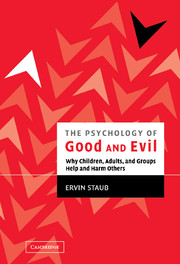Book contents
- Frontmatter
- Contents
- Preface
- Acknowledgments
- PART I INTRODUCTION AND CORE CONCEPTS
- PART II THE ROOTS OF HELPING OTHER PEOPLE IN NEED IN CONTRAST TO PASSIVITY
- 6 Helping a Distressed Person: Social, Personality, and Stimulus Determinants
- 7 Spontaneous (or Impulsive) Helping
- 8 Social and Prosocial Behavior: Personal and Situational Influences and Their Interactions
- 9 The Power to Help Others: Report on a Psychology Today Survey on Values, Helping, and Well-Being
- PART III HOW CHILDREN BECOME CARING AND HELPFUL RATHER THAN HOSTILE AND AGGRESSIVE
- PART IV THE ORIGINS OF GENOCIDE, MASS KILLING, AND OTHER COLLECTIVE VIOLENCE
- PART V THE AFTERMATH OF MASS VIOLENCE: TRAUMA, HEALING, PREVENTION, AND RECONCILIATION
- PART VI CREATING CARING, MORALLY INCLUSIVE, PEACEFUL SOCIETIES
- Appendix: What Are Your Values and Goals?
- Index
- References
7 - Spontaneous (or Impulsive) Helping
Published online by Cambridge University Press: 07 May 2010
- Frontmatter
- Contents
- Preface
- Acknowledgments
- PART I INTRODUCTION AND CORE CONCEPTS
- PART II THE ROOTS OF HELPING OTHER PEOPLE IN NEED IN CONTRAST TO PASSIVITY
- 6 Helping a Distressed Person: Social, Personality, and Stimulus Determinants
- 7 Spontaneous (or Impulsive) Helping
- 8 Social and Prosocial Behavior: Personal and Situational Influences and Their Interactions
- 9 The Power to Help Others: Report on a Psychology Today Survey on Values, Helping, and Well-Being
- PART III HOW CHILDREN BECOME CARING AND HELPFUL RATHER THAN HOSTILE AND AGGRESSIVE
- PART IV THE ORIGINS OF GENOCIDE, MASS KILLING, AND OTHER COLLECTIVE VIOLENCE
- PART V THE AFTERMATH OF MASS VIOLENCE: TRAUMA, HEALING, PREVENTION, AND RECONCILIATION
- PART VI CREATING CARING, MORALLY INCLUSIVE, PEACEFUL SOCIETIES
- Appendix: What Are Your Values and Goals?
- Index
- References
Summary
The Piliavins and their associates have proposed that “there will be (a) special circumstances that give rise to and (b) specific personality types who engage in rapid, impulsive, noncalculative irrational helping or escape behavior following observation of an emergency.” (Piliavin et al., 1975, p. 430). Piliavin (1976) presented a variety of studies in which impulsive helping was supposed to take place, as defined by either average latencies of help in at least one condition of 15 seconds or less or 85% or greater frequency of help. What conditions lead to impulsive helping? Piliavin specifies four conditions that appear at least somewhat related to impulsive helping; in combination they are significantly associated with impulsive helping: (a) The victim must be visible, or there must be clear cries for help; (b) the victim must not be perceived as part of an experiment; (c) the subject must be moving or at least standing; and (d) there must have been a prior meeting between the bystander and the victim. Other conditions that lead to impulsive helping behavior are rapid onset of need and perceived time pressure for help.
Impulsive helping in Piliavin's view is high-probability and/or high-speed helping when rational calculation of costs does not take place. An example par excellence of impulsive helping is provided by Markowitz (1973, p. 75): A passerby sees a boy who is falling out of a sixth-story window, runs over, and catches him. The phenomenon of impulsive helping appears to exist.
- Type
- Chapter
- Information
- The Psychology of Good and EvilWhy Children, Adults, and Groups Help and Harm Others, pp. 100 - 102Publisher: Cambridge University PressPrint publication year: 2003

